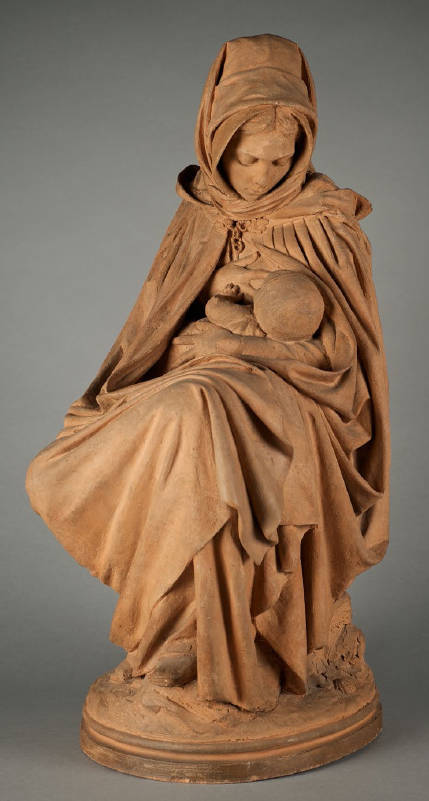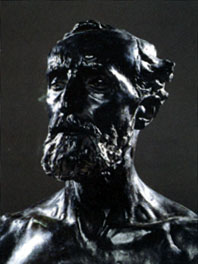



Works showing the range of Dalou's oeuvre. Left: Mother and Child. Middle left: The Truth Revealed. Middle right: Despair Right: The Sower [Click on these images for larger pictures.]

imé-Jules Dalou was one of the great French sculptors of the nineteenth century. Towards the end of his life he was equalled only by his pre-eminent contemporary Auguste Rodin and his sculptures punctuate the end of a romantic tradition that can be traced through the work of David D’Angers, Antoine-Louis Barye and Jean-Baptiste Carpeaux. Previously under-exhibited, if not under-appreciated, Dalou’s work was recently celebrated in a vast survey show at the Petit Palace in Paris (April– June 2013). This exhibition, which consisted primarily of works in plaster and terracotta, gave a scholarly insight into the methods of an artist whose mastery of clay modelling was unsurpassed.


Left: Alophonse Legros’s drypoint portrait. Right: Auguste Rodin's bronze portrait bust of Dalou, 1884. Musée d'Orsay. Click on images to enlarge them.
As the leading sculptor of public monuments in Paris during the 1880s and 1890s, a time when the city was fervently erecting statues to mark the dawn of the new Republic, Dalou gained huge notoriety for his contribution of public art to the French capital. It is however, through editions of his domestic scale models, many of which were never cast in bronze during his lifetime, that he is now best known and collected.
Voluptuous female nudes, gnarled worker figures, mythological scenes, academic portraits, tender young infants and warm depictions of nursing mothers can all be found in his wide ranging oeuvre; informed both by the sculptor’s radical political convictions and his need to please contemporary patrons.
Born in Paris in 1838, Dalou was encouraged by Carpeaux to enrol at the Petit Ecole in 1852. The following year, again under the guidance of Carpeaux, he began his studies at the Ecole des Beaux-Arts under the strict and academic mentorship of Francisque Joseph Duret.
Dalou exhibited at the French Salon throughout the 1860s with limited success, failing to win the Prix de Rome on four successive attempts between 1861 and 1865. Struggling at this stage to get public recognition for his work which was seen as too realist and not sufficiently idealistic, he made a living as a decorating sculptor as an employee of the goldsmiths firm Fanniere Freres. It was not until the end of the decade, when in 1869 his model of Daphne and Chloe was purchased by the French state, that the sculptor began to attract the attention that he deserved. This initial triumph was swiftly followed in 1870 when his model of an Embroiderer was awarded a third class medal and again purchased by the state. Unfortunately both of these plasters were subsequently destroyed.
Politics and social upheaval soon intervened and Dalou was forced to flee the French capital following the fall of the Paris Commune in 1871. His staunch Republicanism and close public affiliation with the Commune, under whom he had assumed the position of the curator of the Louvre, meant he was unsafe in his home city. He escaped to London with his Dalou’s time in London was fruitful. He was warmly welcomed by the French artistic community, including the painter Alphonse Legros, whom he had met during his time at the Ecole des Beaux-Arts. English patrons soon followed and he began exhibiting at the Royal Academy almost as soon as he arrived in England. His Boulonnaise with a Branch was acquired by the Earl of Carlisle, from the Royal Academy exhibition, in 1871.



Left: Charity, also called Maternity. Middle: Boulonnaise carrying her child. Right: La Boulonnaise.
Genre subjects, such as the Boulonnaise, as well as bathers and portrait busts proved popular with English patrons and Dalou achieved significant notoriety-culminating in royal patronage. In 1877 he began teaching a modelling class at the National Art Training School in South Kensington (renamed the Royal Collage of Art in 1896) and also spent a short time teaching at the Lambeth School of Technical Art. It was whilst at South Kensington that Dalou met Princess Louise, who was studying there. This fortuitous Royal introduction quickly led to Dalou being commissioned to make a private memorial to queen Victoria’s grandchildren (now at Windsor Castle), who had died in infancy. The work was well received and Dalou was commissioned to design his first public monument in London. Entitled Charity, the marble group was carved in 1877 and erected behind the Royal Exchange. It was replaced by a bronze cast of the work in 1897.
Through his classes, Dalou encouraged his pupils to adopt clay modelling and free themselves from the legacy of stiff neo-classicism, which had pervaded English sculpture for much of the nineteenth century. His influence was far reaching, and he encouraged a new generation of British Sculptors, whose work came to be known as ‘New Sculpture’. Artists such as Edward Onslow Ford, George Frampton, Goscombe John, and Alfred Gilbert ushered in a new era of British sculpture, indebted largely to the influence of Dalou’s teaching. Indeed, Lord Leighton himself, whose model of an Athlete Struggling with a Python is often seen as the first example of ‘New Sculpture’, credits Dalou for its inception. Leighton had been producing a number of small clay models as sketches for the figures in his painting Daphnephoria (Lady Lever Art Gallery, Port Sunlight) and in an article published in the Studio, 1884, he recalled that his first clay sketch ‘was admired by several people, who took it for a genuine antique, a french sculptor—Dalou, I think… was particularly pleased with it, and advised me to carry it out life size.’
In 1879 an open competition was announced in Paris for submissions to design a monument celebrating the 3rd Republic. Dalou sent his proposal from England for a statue entitled the Triumph of the Republic and although it did not fit the criteria of the designated site, Place de la Republique, his design was commissioned by the state for Place de la Nation. Dalou returned to his home city in 1880 and the monument was unveiled in plaster in 1889. The bronze was cast ten years later and remains one of the best known public works of art in Paris.

Wisdom supporting Liberty for the tomb of Léon Gambetta.
Having returned to Paris from London, Dalou spent most of his time concentrating on large scale monuments and statues to commemorate public figures with whom he felt an affinity. He disliked the process of serialisation and almost never had his smaller works cast for the collectors market. Instead, he produced numerous studies and working models, most of which informed larger scale compositions, but remained in clay or plaster until his death.
Dalou’s staunch republicanism dictated the commissions that he was prepared to undertake and he occasionally offered his services for free if he felt the subject was worthy. One such project, the tomb of the assassinated journalist Victor Noir, ranks amongst the greatest effigies sculpted during the last decades of the nineteenth century.
Other notable public works include the Monument to Delacroix installed in the Luxembourg gardens in 1890, the Monument to Gambetta, completed by Camille Lefevre in 1905 and installed after Dalou’s death in Bordeaux, the tomb of the radical activist Auguste Blanqui and the two large lions sculpted for the left bank of the Alexandre III bridge.
Along with public works, Dalou had also begun to re-exhibit at the French Salon. In 1883 he finally received the coveted medal of honour for two large reliefs, Fraternité and Mirabeau rependant a Dreux-Brézé. Two years later he exhibited his masterful Triumph of Silene, later cast by Thiebaut and installed in the Luxembourg gardens where it remains to this day.




Three views of The Peasant and two of The Small Sower
In addition to smaller scale personal projects, Dalou was engaged for the last decade of his life on a proposed Monument to the Workers. The idea obsessed Dalou, who dreamed of the work as a triumphant final masterpiece, crystallising his left wing ideology and celebrating the ordinary workers of France. The monument itself was never completed, but Dalou made over a hundred small figurines exploring the theme, the most resolved of which, the Grand Paysan, beautifully depicts the strength and stoicism of the worker.
Dalou’s reluctance to cast editions of his work only abated when he felt the need to provide for his family, particularly his handicapped daughter. After the death of his wife, Dalou arranged for his daughter to be cared for by the public Orphanage of the Arts and later bequeathed the entire contents of his studio to the institution in order to provide for her. After his death in 1902, Dalou’s executors made arrangements for a number of models to be cast for the collector’s market. It is these posthumous casts, made primarily by the Susse and Hebrard foundries, that comprise this exhibition and allow us to understand more about what this great sculptor kept hidden in his studio for most of his career.
Bibliography
Aimé-Jules Dalou (1897-1902). Online exhibition catalogue. London: Bowman Sculpture, 2014. Web. 29 November 2014.
Last modified 29 November 2014